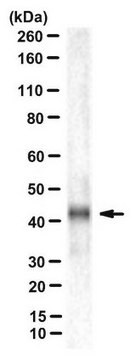AB1857
Anti-Osteocalcin Antibody, a.a. 1-22
serum, Chemicon®
Synonim(y):
Anti-BGP
Zaloguj sięWyświetlanie cen organizacyjnych i kontraktowych
About This Item
Kod UNSPSC:
12352203
eCl@ss:
32160702
NACRES:
NA.41
Polecane produkty
pochodzenie biologiczne
rabbit
Poziom jakości
forma przeciwciała
serum
rodzaj przeciwciała
primary antibodies
klon
polyclonal
reaktywność gatunkowa
human
producent / nazwa handlowa
Chemicon®
metody
ELISA: suitable
radioimmunoassay: suitable
numer dostępu NCBI
numer dostępu UniProt
Warunki transportu
wet ice
docelowa modyfikacja potranslacyjna
unmodified
informacje o genach
human ... BGLAP(632)
Specyficzność
Recognizes human osteocalcin (1-22) mature form. Also reacts with osteocalcin (1-44) and osteocalcin (1-49). No reactivity with human bone sialoprotein and human osteonectin.
Immunogen
Epitope: a.a. 1-22
Synthetic peptide corresponding to amino acids 1-22 of human Osteocalcin (MRALTLLALLALAALCIAGQAG).
Zastosowanie
Anti-Osteocalcin Antibody, a.a. 1-22 detects level of Osteocalcin & has been published & validated for use in ELISA, RIA.
RIA (1:2000)
ELISA (1:5000)
Optimal working dilutions must be determined by the end user.
ELISA (1:5000)
Optimal working dilutions must be determined by the end user.
Research Category
Neuroscience
Neuroscience
Research Sub Category
Hormones & Receptors
Hormones & Receptors
Powiązanie
Replaces: MABD182
Postać fizyczna
Rabbit serum. Lyophilized. Reconstitute with 100 μL of sterile distillled water.
Przechowywanie i stabilność
Maintain lyophilized material at 2-8°C. After reconstitution maintain at -20°C in undiluted aliquots for up to 6 months. Avoid repeated freeze/thaw cycles.
Informacje prawne
CHEMICON is a registered trademark of Merck KGaA, Darmstadt, Germany
Oświadczenie o zrzeczeniu się odpowiedzialności
Unless otherwise stated in our catalog or other company documentation accompanying the product(s), our products are intended for research use only and are not to be used for any other purpose, which includes but is not limited to, unauthorized commercial uses, in vitro diagnostic uses, ex vivo or in vivo therapeutic uses or any type of consumption or application to humans or animals.
This page may contain text that has been machine translated.
Not finding the right product?
Try our Narzędzie selektora produktów.
polecane
Kod klasy składowania
10 - Combustible liquids
Certyfikaty analizy (CoA)
Poszukaj Certyfikaty analizy (CoA), wpisując numer partii/serii produktów. Numery serii i partii można znaleźć na etykiecie produktu po słowach „seria” lub „partia”.
Masz już ten produkt?
Dokumenty związane z niedawno zakupionymi produktami zostały zamieszczone w Bibliotece dokumentów.
Huawen Ding et al.
Journal of cell science, 125(Pt 22), 5564-5577 (2012-09-05)
Nitric oxide (NO) has been shown to play a crucial role in bone formation in vivo. We sought to determine the temporal effect of NO on murine embryonic stem cells (ESCs) under culture conditions that promote osteogenesis. Expression profiles of
Laurent A Tchang et al.
Journal of tissue engineering and regenerative medicine, 11(5), 1542-1552 (2015-06-17)
The use of fetal bovine serum (FBS) as a culture medium supplement in cell therapy and clinical tissue engineering is challenged by immunological concerns and the risk of disease transmission. Here we tested whether human, thrombin-activated, pooled, platelet-rich plasma (tPRP)
Rodrigo A Grandy et al.
Molecular and cellular biology, 36(4), 615-627 (2015-12-09)
Stem cell phenotypes are reflected by posttranslational histone modifications, and this chromatin-related memory must be mitotically inherited to maintain cell identity through proliferative expansion. In human embryonic stem cells (hESCs), bivalent genes with both activating (H3K4me3) and repressive (H3K27me3) histone
Elena Filová et al.
International journal of nanomedicine, 9, 3687-3706 (2014-08-16)
Hydroxyapatite (HA) is considered to be a bioactive material that favorably influences the adhesion, growth, and osteogenic differentiation of osteoblasts. To optimize the cell response on the hydroxyapatite composite, it is desirable to assess the optimum concentration and also the
Laminin-5 induces osteogenic gene expression in human mesenchymal stem cells through an ERK-dependent pathway.
Klees, RF; Salasznyk, RM; Kingsley, K; Williams, WA; Boskey, A; Plopper, GE
Molecular Biology of the Cell null
Nasz zespół naukowców ma doświadczenie we wszystkich obszarach badań, w tym w naukach przyrodniczych, materiałoznawstwie, syntezie chemicznej, chromatografii, analityce i wielu innych dziedzinach.
Skontaktuj się z zespołem ds. pomocy technicznej








